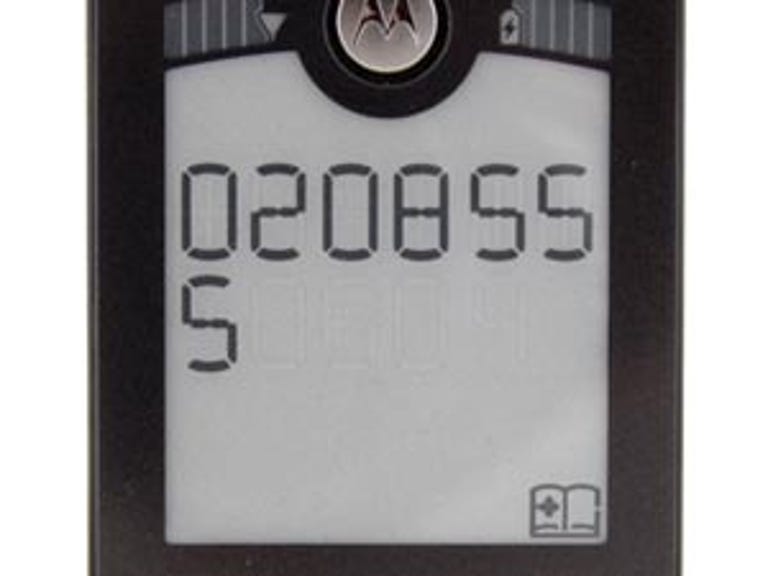 Why You Can Trust CNET
Why You Can Trust CNET Motorola Motofone F3 review: Motorola Motofone F3
Motorola's new Motofone F3 is the phone many people are looking for -- one without all the fancy-pants extras. There's no camera, no Internet and none of that multimedia nonsense, just calls, texts and great battery life. What could possibly go wrong?
Motorola's new Motofone F3 is the phone many people are looking for -- a handset without all the fancy-pants extras built in. It makes calls, does text messages and that's it.
The Good
The Bad
The Bottom Line
There's no camera, no Internet access and none of that multimedia nonsense. It's also very slim and has the longest battery life we've seen in ages.
Our review model came from Phones4U on a pay as you go tariff with a T-Mobile SIM, for £15. You have to buy it with £10 of credit, so overall it will cost you just £25 to get your hands on one. With a price like that, what could possibly go wrong?
Strengths
At only 9mm thick this phone slips into a pair of tight jeans or the inside of a packed bag without any trouble. The Motofone F3 also feels pretty sturdy and its matte surfaces mean no noticeable fingerprint stains.

The F3 has an electrophoretic screen, quite unlike the normal colour LCD on most modern mobiles -- it's more like a calculator. Unlike phone screens, there's no backlight, so it uses much less power. We charged it once and it lasted for over two weeks on standby without any problems.
Another advantage of the electrophoretic technology is the black characters on the white background are easy to read, even in bright sunlight. So if you find yourself constantly covering your mobile's screen outside to see what's going on, the F3 is worth checking out.
We really like the network strength and battery gauge sections on the top right and left of the screen -- they look great and are large and easy to see. The large letter and number characters pop up like calculator digits and are clear as day.
Similar to the majority of other Motorola phones, the F3 features a flat keypad divided up by curved rubber lines. The navigation button and the number keys are large and easy to press and the curved rubber lines on the keypad make it easy to distinguish between keys.
Weaknesses
Having made what could potentially have been one of the best budget phones ever, it was a huge disappointment to see Motorola has allowed some fatal flaws into the F3's interface.
It took us quite a long time to work out how to use the most basic functions initially, even with the manual by our side.
According to the F3's online product page it "offers a redesigned user interface with innovative voice prompts in local languages to guide the user quickly and easily through menu navigation, messaging, and other functions. In addition, graphical icons visually demonstrate the menu features."
But the problem is it's not always appropriate to have voice prompts turned on, and navigating the menu system without the voice prompts is hugely awkward. Those graphical icons really don't cut it.
Maddeningly, you need to input code numbers from the manual to adjust certain settings, such as changing the language or setting a voicemail number, like when using a cheap universal remote control. For instance, to turn off keypad tones you have to press star three times, then 251, another star and then the action key. Got that? Good, you'll have to remember it, or carry the manual around with you.
The other problem is that the letters, although easy to read, are so large that long text messages or contact names don't fit on it without scrolling. It's like trying to read a text message on a calculator.
Conclusion
Albert Einstein once said, "Everything should be made as simple as possible, but not simpler." While the Motofone should be one of the simplest ever phones to use, it's actually about as user-friendly as a Rubik's cube. It will definitely take some getting used to, especially if you've owned any other mobile phone before.
We really wanted to like this phone -- the battery life is incredible -- but after using it for over two weeks, we couldn't stand it any longer. One of the most annoying features is the inability to read text messages in one go and having to scroll through them bit by bit. If you're a heavy texter, avoid this phone at all costs.
That said, if you only care about making calls and you have all the numbers you need stored on your SIM card, then the Motofone's fantastic battery life might make it worth a purchase. Just don't plan on texting any time soon. Or adding any new contacts. Or changing any of the settings if you lose the manual. Or...
Edited by Jason Jenkins
Additional editing by Nick Hide
